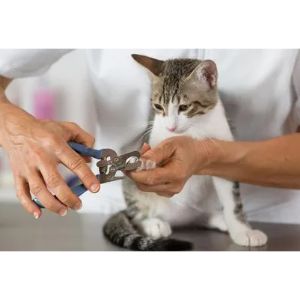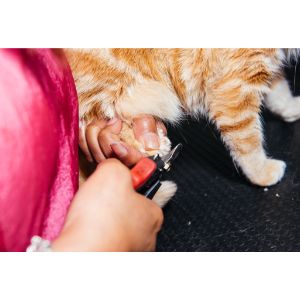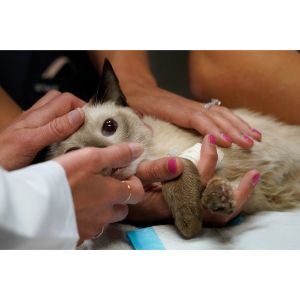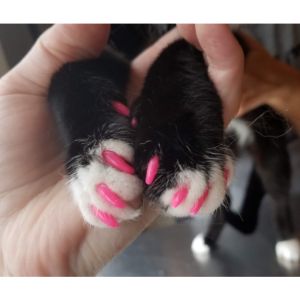Declawing is a surgical technique that involves removing the last bone from a cat’s front paw. The skin and bone are sliced throughout the procedure. However, this operation can be a bit expensive – which is why we have the question where can I declaw my cat for free?
Cats’ claws are commonly removed because people find them to be an annoyance, but they may also be removed for medical reasons. There are a few places you can declaw a cat for free.
There are many places you can get a cat declawed for free, including the humane society, kitten rescue groups, cat shelters, locally trained in-home vets, veterinary schools, and animal behaviorists or pet psychologists.
Keep reading as we discuss where you can declaw your cat for free.
Where Can I Declaw My Cat for Free?

Here is a rundown of the most popular locations where you can declaw your cat for free:
1. The Humane Society

Cats can be declawed at The Humane Society’s Mobile Spay and Neuter Clinic. You probably won’t have to make any out-of-pocket payments; their price is set by income. More details regarding their program are available online.
However, to be eligible for free HSUS treatment, your cat must be declared unadaptable or undersocialized.
These are harsh words that shouldn’t be used to describe our creatures; even declawing should be viewed as cruel. The PawSpree sites run by the Petco Foundation are yet another spay/neuter facility that provides low-cost care to animals in need.
2. Cat Rescue Organizations

There may be several free and inexpensive spay/neuter clinics nearby, based on where you reside. It’s crucial to spay or neuter your cat before it reaches sexual maturity if you wish to keep it healthy for the rest of its life.
Most towns and cities have at least one nearby feral cat rescue group that can help you with these steps or offer interim lodging until your kitten gets accustomed to living in a home.
In the absence of a rescue organization, contact your neighborhood shelter and any national groups like PetSmart Charities.
It shouldn’t be difficult to locate one of these clinics if you do some internet research, speak with friends and relatives who may already have cats, and phone local shelters.
3. Cat Shelters

Many animal shelters and humane societies perform declawing procedures since many cat lovers want to have their cats’ claws removed to keep them protected and out of harm’s way.
For instance, the Orchard Humane Society in Detroit provides inexpensive cat declaw operations, although other animal shelters and humane societies may provide discounted or no-cost procedures.
Also noteworthy is the fact that some groups, such as The Humane Society of New York City, do not offer or advocate surgical declaw operations.
Additionally, get in touch with your neighborhood ASPCA chapter; they might be able to point you in the direction of free or inexpensive services in your region.
Even some breeders could be open to saving money by declaw-ing a whole litter of kittens in one go!
4. In-Home Local Veterinarians

Going to a qualified in-home vet is advantageous because they are already acquainted with your pet. They may even be close to your cat, which helps lessen some of the anxiety associated with a declaw procedure.
You don’t even need to get dressed or leave the house if you choose not to; in-home vets will make house calls.
Additionally, it appears that most individuals only consider their neighborhood in-home veterinarian after exhausting a few other options.
Therefore, if a person has already gone through all those inconveniences and still chooses an in-home visit, you can be sure that they sincerely wanted to avoid going to a vet’s office and probably wouldn’t gripe about it excessively later.
5. Veterinary Schools

The majority of veterinary colleges provide free cat declawing as a part of their graduate training. In some circumstances, your cat might need to get care on campus while being kept apart from other cats.
The majority of schools also provide a pain management strategy.
Therefore, if you have some extra time before your cat needs to have its claws amputated and you live close to a vet school with an authorized veterinary medical degree, it is well worth looking into.
Call ahead and inquire about their regulations and process before going; not all establishments will give out declawing procedures for free.
Before scheduling a consultation, be certain that you can follow any rules that your neighborhood veterinary school may have established. This likely includes having your kitty up to date on vaccinations.
6. Pet Psychologists or Animal Behaviorists

Pet psychologists are cat therapists that focus on feline behavioral problems such as clawing furniture as well as other animals.
Don’t be afraid to contact your neighborhood pet psychologist if you’re weary of your cat’s violent or destructive behavior; it could be just what you both need.
Additionally, keep in mind that most professionals will work with your budget if you’re concerned about seeking their help (i.e., some are more costly than others).
Additionally, pet psychologists offer guidance and instruction for a variety of other elements of your cat’s life, such as litter box troubles and food challenges.
What are the Benefits and Risks of Free Declawing My Cat?

Declawing your cat carries certain benefits and dangers. The primary dangers are that declawed cats may endure pain and discomfort and that they could find it more challenging to move about.
Since their claws no longer offer defense from cuts and scratches, cats that have lost their claws are also more likely to become infected.
With no longer needing to scratch to establish their territory, cats use fewer litter boxes, leave fewer scratches on furniture, and exhibit less anxiety, which helps some cats with aggressive behavior.
However, there are disadvantages to cat declawing as well. Declawed cats, for instance, may be less inclined to climb a tree or staircases, to scratch as much, and they may have issues using the “toilet” if they can’t readily access it.
Before deciding, it’s critical to consider both the advantages and disadvantages of declawing.
Alternatives to Declawing

In this section, we’ll discuss some of the well-known, safer alternatives to declawing.
Training
Cats scratch naturally; therefore, you do not want to completely stop your cat from doing so. However, you may train your cat where and when it is okay to scratch and where and when it is not.
Start by supplying a lot of scratch poles, cat trees, and scratchers in a range of materials and locations around your home to promote pleasant scratching behaviors.
Reward your cat for appropriate scratching habits and guide them to the scratching posts if they start to claw on the sofa or other items they shouldn’t.
When your pet scratches while you’re playing, gently place them down and leave. Your cat will be far less inclined to scratch you in the future if you divert your attention, which will serve as reinforcement that you don’t enjoy the behavior.
Nail Trimming
Your pet may occasionally scratch your furniture and other items if their nails are troubling them in any way.
Consider your furniture as a more costly emery board: They choose your furnishings because they appear to be helpful when they are trying to polish or grind down their nails.
Trim your pet’s nails short to prevent this cause of scratching as well as to help lessen any harm from another scratching.
Understand how and when to trim your pet’s nails and make an investment in a decent pair of cat nail clippers. Your vet or a cat groomer might be able to assist you if you lack the confidence to cut your cat’s nails yourself.
Nail Caps

You may purchase vinyl nail caps to help reduce damage if teaching your cat not to claw doesn’t appear to be working.
These smooth caps, which include transparent, glitter, and fluoresce options, paste on your cat’s claws.
The nail caps are generally well tolerated by cats, but your kitty may need some warming up to. As your cat’s nails develop, each pair of caps gradually sheds after 4 to 6 weeks.
Feliway
A synthetic pheromone called Feliway is sold as a spray or a plug-in for rooms.
Feliway, a medication frequently used to induce cats to cease urine marking or to lessen other aggressive behaviors, can also help prevent scratching.
Environmental Enrichment
Cats’ destructive scratching might happen when their requirements are not fully addressed. To engage in their natural activities and have power over their social connections, cats require the right supplies. The necessities for your cat include:
- Food: set aside specific mealtimes and bowls for each cat in your home.
- Water: clean, fresh water in a place your cat finds pleasant.
- Litterbox: practical, hygienic, and private
- Secure location to rest
Face-rubbing and scratching on surfaces leave your cat’s fragrance and add a distinctive imprint to the familiar territory.
Speak with a Specialist in Animal Behavior
If none of the aforementioned suggestions have worked, you might want to think about hiring an animal behaviorist.
If you want to regulate or change your cat’s behavior, behaviorists may examine your cat’s history, temperament, surroundings, and responses to different situations.
Conclusion For “Where Can I Declaw My Cat for Free”

To sum up, if you’re wondering, “Where can I declaw my cat for free?” there are a few locations to choose from.
To determine if the service is free, you may also try searching online or getting in touch with your neighborhood humane organization or animal shelter. Lastly, before moving further, be careful to inquire about any potential constraints.
If you want to learn more about declawing your cat, you can, by watching “The Truth About Declawing Your Cat” down below:




